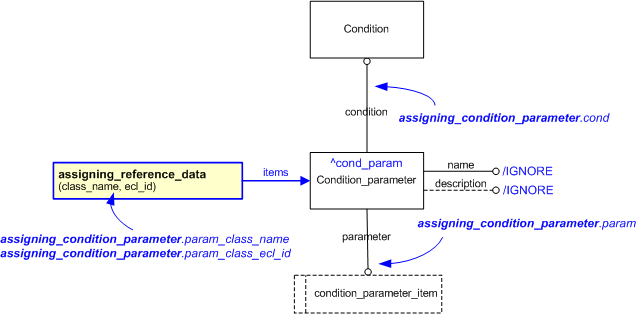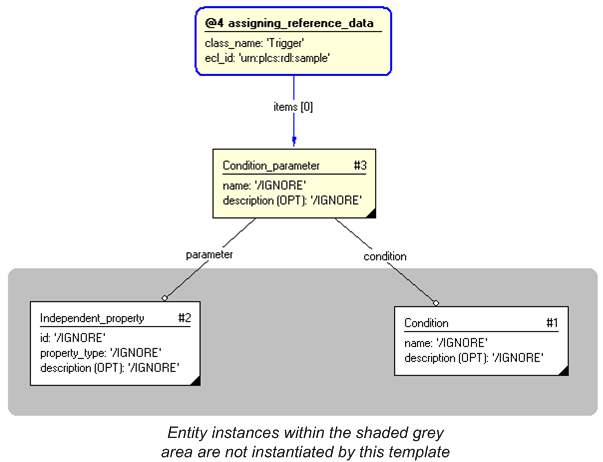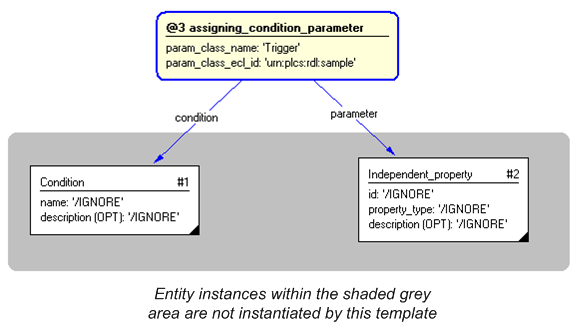Template:— assigning_condition_parameter (asg_cond_para)
Capability:representing_condition |
Date: 2010/11/28 21:13:41
Revision: 1.1
|
This section specifies the template assigning_condition_parameter.
NOTE
The template has been defined in the context of the capability
representing_condition
which provides an overall description of the
relevant parts of the ISO 10303-239 information model and a description
of related templates.
NOTE
An explanation of a template and the associated instantiation path is
provided in the
Template overview
section.
This template describes how to represent the assignment of a condition parameter to a condition.
The EXPRESS-G diagram in
Figure
1
shows the templates and EXPRESS entities that are required
to represent the template
"assigning_condition_parameter".
The text highlighted in blue shows the template parameters.
Figure 1 — An EXPRESS-G representation of the Information model for assigning_condition_parameter
The graphic for the template to be used in other EXPRESS-G diagrams
is shown in Figure
2
below.
Figure 2 — The graphical representation of the assigning_condition_parameter template
The following input parameters are defined for this template:
The condition
to which the condition parameter is assigned.
The item that is used as a condition parameter.
The name of the
External_class used to classify the condition parameter, and so
provide the role of the condition parameter.
The following classes and their sub-classes can be used:
The following reference parameters are defined for this template:
Allow the
Condition_parameter
entity instantiated in this path to be referenced when this template is used.
%^target = $assigning_condition_parameter.cond_param%
The following parameter combinations specify a uniqueness constraint:
Unique constraint: Condition parameter
The instantiation path shown below specifies the entities that are to be
instantiated by the template.
A description of templates and the syntax for the instantiation path is
provided in the
Templates Help/Information section.
The following entities are instantiated with attributes as specified:
The instance diagram in Figure
3
shows an example of the EXPRESS entities and templates that are instantiated by the template:
/assigning_condition_parameter(cond='#1', param='#2', param_class_name='Trigger', param_ecl_id='urn:plcs:rdl:sample')/
(an illustration of the consolidated assigning_condition_parameter template is shown in
Figure
4 below.)
Figure 3 — Entities instantiated by assigning_condition_parameter template
The instance model in STEP ASCII exchange file format (ISO 10303 Part
21 syntax) is:
#1 = CONDITION('/IGNORE','/IGNORE');
#2 = INDEPENDENT_PROPERTY('/IGNORE','/IGNORE','/IGNORE');
#3 = CONDITION_PARAMETER('/IGNORE','/IGNORE',#1,#2);
#5 = CLASSIFICATION_ASSIGNMENT(#6,(#3),'/IGNORE');
#6 = EXTERNAL_CLASS('/NULL','Trigger','/IGNORE',#7);
#7 = EXTERNAL_CLASS_LIBRARY('urn:plcs:rdl:sample','/IGNORE');
The instance model in STEP XML exchange file format (ISO 10303 Part
28 ed.2 syntax) is:
The instance diagram in
Figure
4
shows the graphic symbol for the template that is to be
used in other instance diagrams. The example template is:
/assigning_condition_parameter(cond='#1', param='#2', param_class_name='Trigger', param_ecl_id='urn:plcs:rdl:sample')/
Figure 4 — Instantiation of assigning_condition_parameter template
Characterizations
No common characterizations of the template
assigning_condition_parameter
have been identified. However, the ISO 10303-239 EXPRESS model
may enable other assignments to the entities instantiated by the template.




